Butterflies are probably one of the most popular insects. We introduce you to the fifteen most beautiful butterfly species native to Germany.

When you think of summery meadows and gardens, you also think of the colorful butterflies. Their diversity is also colorful with around 3700 species in Germany. Unfortunately, many are now threatened. In the last ten years, the number of native butterflies has decreased by ten percent and more and more species are classified as endangered. What helps? Colorful gardens in which things can sometimes get a bit wilder. Here are ten wonderful native butterfly species that will thank you.
contents
- 1. Pigeontail (Macroglossum stellatarum)
- 2. Painted Lady (Vanessa cardui)
- 3. Brimstone butterfly (Gonepteryx rhamni)
- 4. Peacock butterfly (Inachis io)
- 5. Swallowtail (Papilio machaon)
- 6. Lesser Tortoiseshell (Aglais urticae)
- 7. Admiral (Vanessa atalanta)
- 8. C moth (Polygonia c-album)
- 9. Checkerboard (Melanargia galathea)
- 10. Aurora Butterfly (Anthocharis cardamines)
- 11. Big fox (Nymphalis polychloros)
- 12. Imperial Mantle (Argynnis paphia)
- 13. Mourning Cloak (Nymphalis antiopa)
- 14. Common Blue (Polyommatus icarus)
- 15. Small Meadow Bird (Coenonympha pamphilus)
Depending on the environmental conditions, special shapes and colors of butterflies develop. Around 1900 there was extensive research: It was found that high or low temperatures and unusual food during the caterpillar stage lead to extreme deviations. This explains why individual species look different than they should in certain areas or particularly hot years. Particularly large effects were observed with the mourning cloak, which showed clear characteristics of the big fox when exposed to cold. Below we present 10 native butterfly species that you might also find in your garden.
1. dovetail (Macroglossum stellatarum)
A very unusual butterfly is the pigeon tail. It is particularly noticeable because of its weighty body. At first glance it is sometimes mistaken for a hummingbird, although hummingbirds are of course not found in Europe. Nevertheless, this comparison is not so far-fetched, because of its size and especially its ability to remain buzzing in front of a flower, there are definitely similarities. Pigeontails have a proboscis about an inch long that allows them to drink on the fly. They mainly choose flowers with a long calyx. The fast, agile animals mostly migrate to Mediterranean regions in winter, but more and more pigeon tails have recently been spending the winter in Germany.

2. Painted Lady (Vanessa cardui)
Unfortunately, if you want to discover the Painted Lady in winter, you will look in vain. In fact, the pretty butterfly only occurs in Germany from April to September and moves to warmer regions in winter. The small animals fly up to 4000 kilometers to the Ethiopian highlands - one of the longest known insect migrations in the world. With its striking orange color, which is emphasized by black and white patterns, the Painted Lady is particularly impressive with its appearance. In addition, the adult animals are extremely lovable beneficial insects that reliably pollinate thistle flowers in particular. The caterpillars of the painted lady like to use thistles (Cirsium), the common nettle (Urtica dioica) or mallow (Malvaceae) as forage plants.
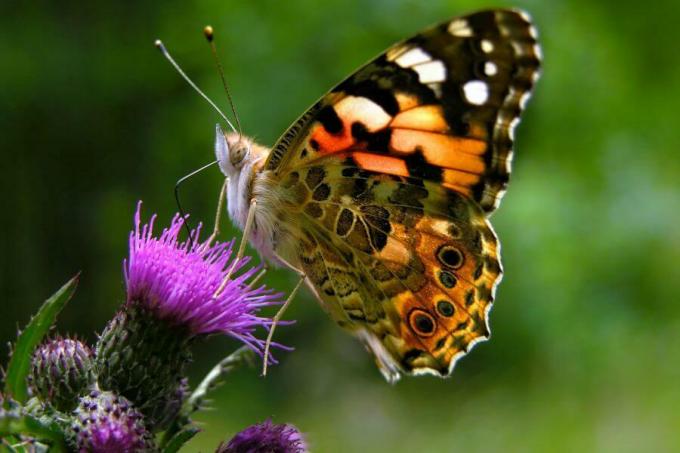
3. brimstone butterfly (Gonepteryx rhamni)
The first butterfly to flutter around in spring is the brimstone butterfly. It has the amazing ability to excrete a large part of its body fluids in cold winters, enabling it to withstand temperatures as low as -20°C. As soon as it gets a little warmer again, it wakes up from its hibernation. In midsummer, the animals fall into a second phase of rest, the summer rest. They are the only German butterfly that can live up to ten months. Brimstone butterflies are easily recognized by their distinctive leaf-like shaped wings. Male specimens are lemon yellow, while female animals are more greenish yellow.

4. peacock butterfly (Inachis io)
The peacock butterfly is one of the most common butterflies in Germany, Austria and Switzerland. It is easily recognizable by its four large peacock eyes on the red-brown upper side of its wings. Since the animals do not migrate, but in slightly damp places such as in cellars or burrows overwinter, they are among the butterflies that are the first to return in spring, as soon as it is gets warmer. The caterpillars of the peacock butterfly are also clearly visible. They sit almost exclusively on stinging nettles and are deep black in color with white dots. The butterfly's defense strategy is striking: if an attacker approaches, the peacock butterfly strikes flicks its wings to show off its eyes, and gives a loud hiss at the same time yourself.

5. swallowtail (Papilio machaon)
With a wingspan of up to eight centimetres, the magnificent swallowtail is one of the largest of our native butterflies. Its wings are strikingly patterned with a blue stripe along the lower edge and elongated appendages. Populations of the impressive moth have recovered in recent years, and it can now and again be seen on flower meadows or in gardens. He is particularly fond of gardens with carrots, dill and fennel. During the mating season between May and August, swallowtails are also often seen on hilltops where males and females meet. The female lays the eggs on individual umbellifers, but only so few that the plant is not damaged too much by the caterpillars.
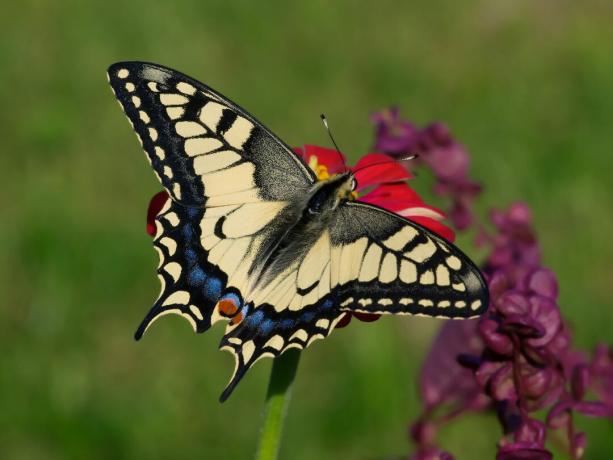
tip: Would you like to attract more native butterfly species to your garden or balcony? Then you are at ours Plantura butterfly meeting precisely. Simply sow the mixture of annual and perennial butterfly-friendly plants in the bed or in the pot and you will soon be able to watch the colorful fluttering.
6. Little fox (Aglais urticae)
Orange-brown wings with bright blue dots on the edge: the little tortoiseshell is extremely popular because of its pretty shape. In Germany, the little tortoiseshell is often found in summer and is one of the most popular butterfly species. In fact, the moth is a hard-working pollinator and shines with more than just its looks. Well over 200 different nectar plants are flown to by the little fox. In addition to numerous native plants such as the water daffodil (Eupatorium spec.) include exotic garden plants such as the butterfly bush (Buddleja). If you want to offer the beautiful butterflies a home, you should not only pay attention to plentiful flowering plants: the caterpillars of the small tortoiseshell feed almost exclusively on the common nettle (Urtica dioica), which is why the moths are often found near these plants.
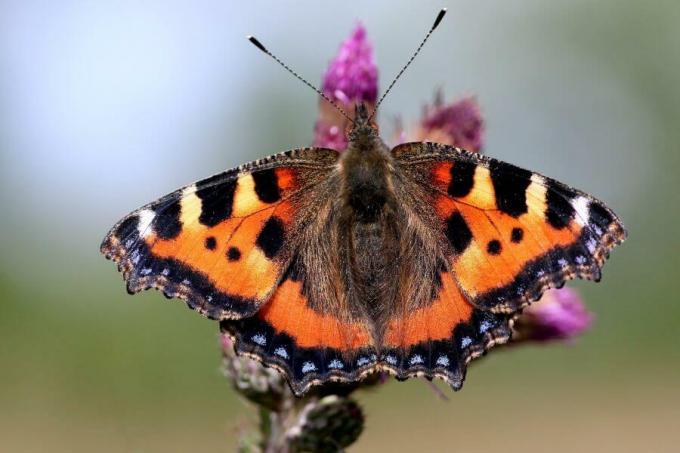
7. admiral (Vanessa atalanta)
You often meet the admiral in the garden. This butterfly species is not particularly specialized in its habitat requirements. It inhabits open landscapes with meadows and fields, can be found in forest clearings and orchards, but also in gardens. She likes to drink there phlox, Buddleia or goldenrod. Its caterpillars feed on nettles. The admiral is dark brown on top, bordered by a red border. The wing tips are black with white markings. The Admiral doesn't survive cold temperatures - that's why he wanders butterfly in winter in southern regions of Europe.
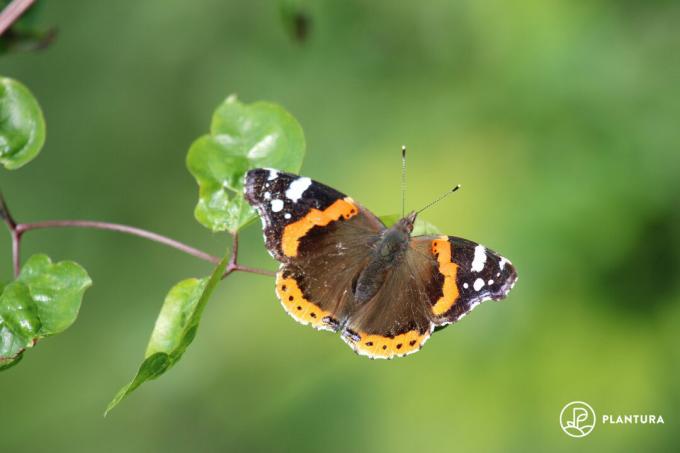
8. C-Folder (Polygonia c-album)
The C-fold owes its unusual name to its unique identifying feature: While the upper side moth is patterned orange-brown, there is a distinctive white "C" on the underside of the hind wings away. In Germany, the C moth can be found quite frequently. He feels particularly comfortable in damp locations, but he also likes to visit parks and gardens. Here, the C moth particularly pleases ambitious gardeners: Since it prefers to drink the nectar of berry bushes, the C moth is considered an extremely good pollinator for them. The myth that C moths suck berries, on the other hand, is false. Although the moths like to suck plant juices in summer, they only use fallen fruit or fruit that has already been injured. The caterpillars of the C moth often use the stinging nettle and the willow willow (Salix). Also the gooseberry (Ribes uva crispa) and the red one currant (Ribes rubrum) belong to their forage plants.
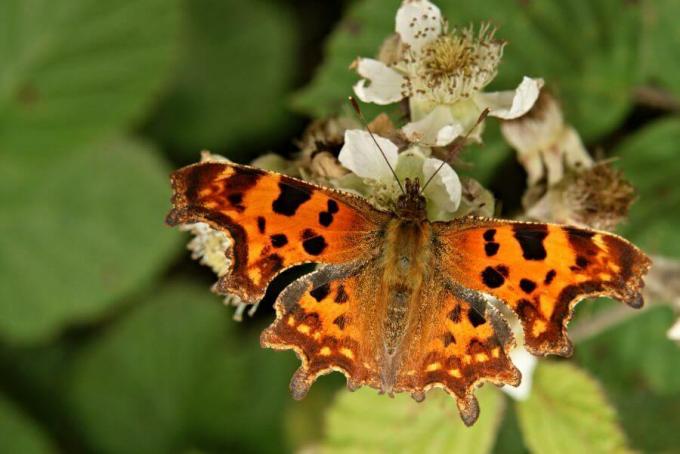
9. checkerboard (Melanargia galathea)
The chessboard was awarded Butterfly of the Year 2019. The butterfly attracts attention with its striking black and white pattern and prefers nutrient-poor flowering meadows, flying to purple to violet flowers such as thistles and scabious. However, the meadows may not be mowed until the end of July in order to be able to serve as a food source for the butterflies. The checkerboard female drops her eggs to the ground in flight, where the caterpillars hatch. Therefore, leave a few corners in the garden unmowed - the chessboard and other insects will gratefully accept this offer.

10. Aurora Butterfly (Anthocharis cardamines)
When meadow smock and garlic mustard are in bloom, the Aurora butterflies are not far either. The whitish butterfly lives in meadows and in sparse forests. Males can be distinguished from females by bright orange wingtips. However, both sexes have white and green patterned wing undersides. The animals are solitary animals and survive the winter as pupae, from which they then hatch in the spring.

11. big fox (Nymphalis polychloros)
With an amazing size of 50 to 55 millimeters wingspan, the greater tortoiseshell is one of the giants among butterflies in Germany. With its orange-red coloring and its black-yellowish pattern, the big tortoiseshell is also a real feast for the eyes. It is often confused with the little fox, although the two are not closely related. Unfortunately, the big fox has become rare in Germany. Especially the loss of its habitat, which consists of semi-open landscapes, sunny forest edges and semi-natural meadow orchards ensure that the big fox is now on the early warning list for endangered animals stands. When it comes to finding food, on the other hand, the big fox is a real all-rounder: while the caterpillars scavenge leaves of various deciduous tree species, the big tortoiseshell feeds on nectar as well as plant sap or windfall. The moth does not even stop at excrement or carrion when it comes to food intake.
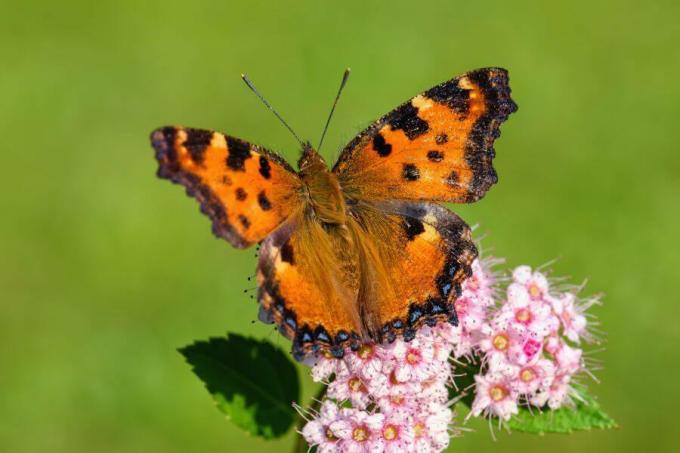
12. imperial mantle (Argynnis paphia)
The Kaisermantel inhabits near-natural forests, forest edges and recently also gardens and bushes. The males have an intense orange upperside with a black-brown pattern on the wings. Females are a bit browner, in eastern Germany there is even a green-bluish color variant of the imperial mantle female. Underside, the wings of imperial cloaks are greenish-white with a tinge of silver. The animals feed on the nectar of thistles, dost and blackberries, but also summer lilac. They lay their eggs on tree trunks, where the caterpillars hatch and overwinter before feeding on wild violets in spring.

13. mourning cloak (Nymphalis antiope)
A very special butterfly is the mourning cloak. Its name doesn't exactly sound cheerful, but it is probably due to its velvety-brown wing surface. This is framed by a border of blue dots and finally a cream-colored, jagged border. The mourning cloak is one of the large butterfly species and can have a wingspan of up to three inches. However, it only feeds on willow blossoms in the spring. The rest of the year he prefers fallen fruit and leaking tree sap. Its natural home is open, moist forests with pastures, birches and elms. Nevertheless, it can also be seen from time to time in meadow orchards and even gardens.
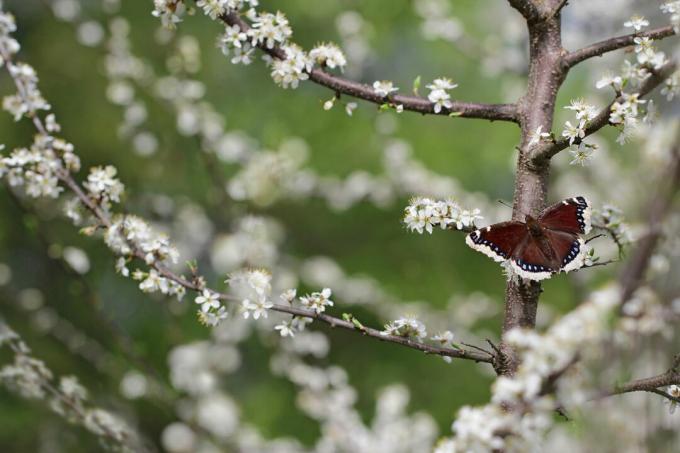
14. Common Blue (Polyommatus icarus)
There are many different types of blues, and as the name suggests, they are identified by a bluish tinge. The most common species is the common blue. The males have an intense blue color on the upper side of their wings. Females, on the other hand, are mainly brown, but still have a blue cast. The underside of the wings is conspicuously dotted with black and orange on a light background and the wings themselves are lined with a light fringed border. Appropriately, the butterfly species only lays its eggs on legume plants - for example white clover and thorn clover.
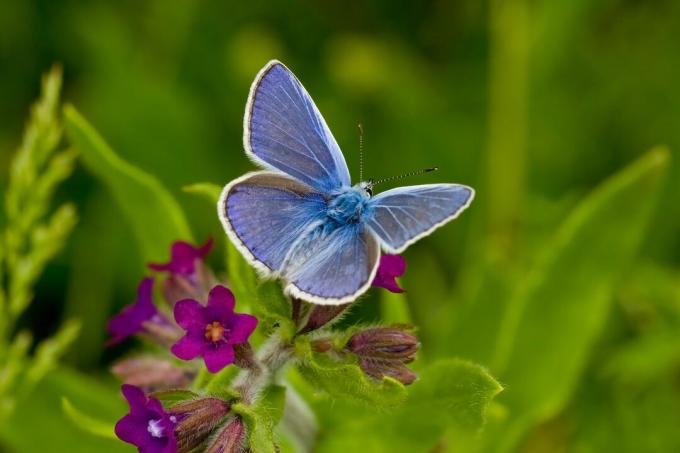
15. Little Meadow Bird (Coenonympha pamphilus)
Admittedly, with its brown-ochre-colored wings, the small forest bird is not exactly the most conspicuous representative of the butterflies. Nevertheless, one should not underestimate the little moth. Since the nectar of wild plants such as the field scabious (Knautia arvensis) or buttercup species (Ranunculus), but also daisies (Leucanthemum) and heather (erica) are on the menu, it is considered an important pollinator. The little meadow bird is generally not choosy and sucks on almost all flowering plants that it can find in its territory. As its name suggests, this useful moth is particularly common in open grassy areas such as meadows, nutrient-poor grassland and pastures. Its caterpillars feed mainly on sweet grasses, for example meadow grass (Poa pratensis), but also real sheep fescue (Festuca ovina) and mat grasses (Nardus) on their menu.
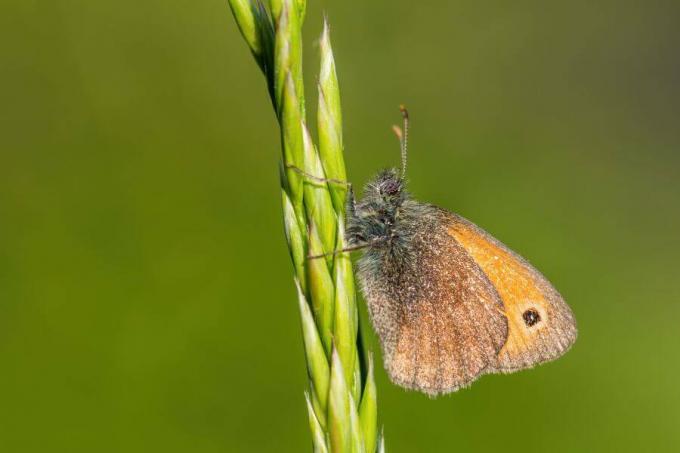
If you want more on the subject Species diversity and biodiversity If you want to know, we have an article for you here. How to own one butterfly house builds, we show in this article.



